Do you ever feel like you aren’t gaining the traction you’d like to with your planning efforts?
I totally relate.
Why we need weekly dashboards
I think we’ve all experienced the confusion and frustration of trying to get our lives organized and under control, but feeling like we’re missing a piece somewhere. I personally can’t stand feeling that way, so I set out to determine what the essential pieces were and how I’d handle them. Then if it didn’t work, I’d know the problem was me and not the plan.
It was time for me to stop creating new planning routines and methods and stick with what worked, but first I had to know I had the parts I needed so I could focus on the actual doing without allowing myself to blame the system and return to the drawing board. Being at the drawing board with a plan is fun for me, but the real progress and leverage happens in the implementation of the plan, not the creating of the plan.
The problem with weekly plans
The biggest obstacle we have in working a plan is actually trust. When we get our head clear with a brain dump, it’s only going to stay clear if we have places to put the information we’ll need and we trust we’ll see it when we need it.
If we are unsure about whether or not what we need will come in front of our eyes when we need it, then our minds will take it back and try keeping track of it all internally again and the brain dump will have been wasted effort. The key to letting it go so our minds can do what they are good at – creative problem-solving and in-the-moment noticing – is having a complete system that we trust.
We don’t trust our plan because we fear not being able to be flexible.
We know that real life doesn’t follow our plans, so our planning time becomes wishful thinking time where we imagine all we could do if things go our way. As soon as things don’t go our way (like first thing Monday morning), we toss the plan out the window.
Keep your real life in view
We have to do that, because that plan wasn’t made for real life.
Instead of wasting time on wishful thinking plans, we need to make plans in light of our current reality and use them not as a tool of control against others, but as a tool to control our own moment-by-moment choices – even if that choice is to switch gears and take care of the current urgent, unexpected need.
Our plans should help us make those judgement calls with calm clarity and consistent conviction.
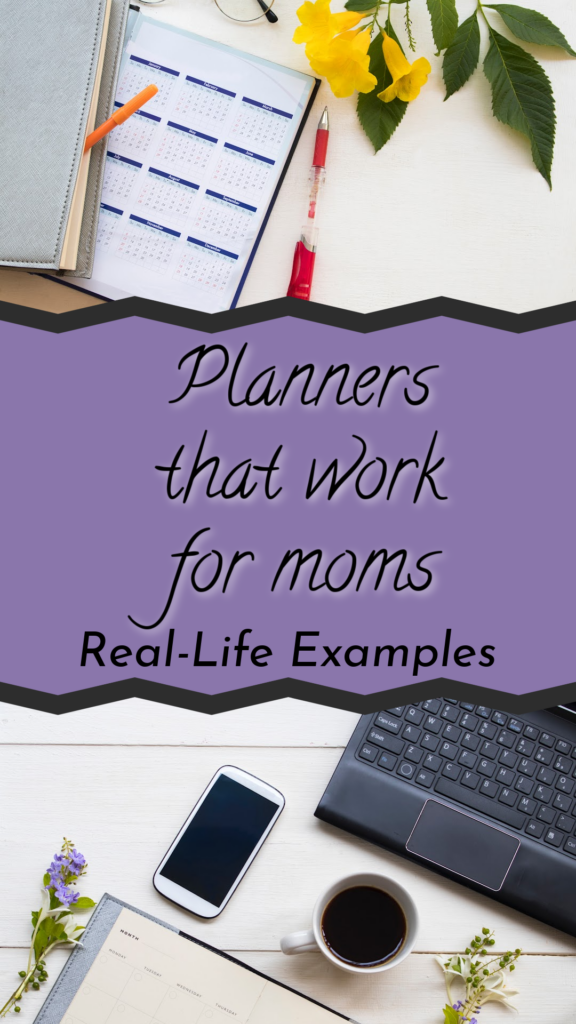
How to get started with a planner
Setting up a new planner can seem daunting and maybe not even worth the time.
But a working planner does save more time than it takes, as long as you don’t waste time in wishful thinking instead of real planning.
Setting up a planner involves creating 5 different sections. The format or material doesn’t matter much. Using it is everything.
Planner organization can seem complicated, but it really doesn’t need to be.
Here are the brass tacks of planner set-up:
- List current projects.
- Update your calendar so it’s complete and correct, with the next 3 months visible.
- Have a set of lists for your week
- Have a list of your daily top 3
- Have a space for taking notes and keeping running lists and thoughts.
Sarah’s weekly planner dashboard on a whiteboard:

“Writing out the things each week helps. When we get to school time, I sometimes use a wet erase marker for the things that stay the same each week. The second board gets used for whatever is needed – currently kid jobs, sometimes brain dump, running to do, etc.”
—Sarah Nelson, Convivial Circle Mentor Member
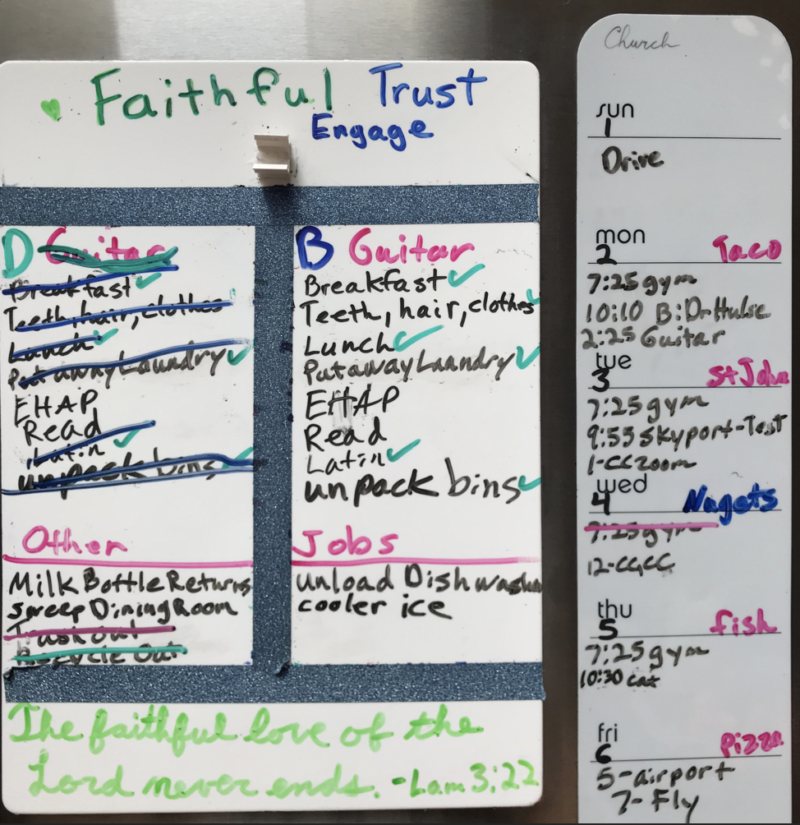
Keep it simple with a weekly dashboard
Planners don’t have to be one-size-fits-all and they don’t have to be confining or busy work.
Keeping a weekly dashboard – in any format – will help you keep your plates spinning when life is hectic and busy.
The weekly dashboard is the heart of your planner.
Your planner might have a lot of moving pieces, but the workhorse, the essential piece, is the week-at-a-glance view.
No matter what kind of planner you keep, you need a weekly dashboard.
There is no one right way to keep or make a planner. We each simply need a place to write things down.
What we need to keep on our dashboard and what we keep on it needs to change based on what’s going on in our life at the time.
Rachael’s Weekly Dashboard printable:

“Our scheduled activities are few right now, so I just list those in the “tasks for this week” section. I can foresee a season coming where I will need more structure to keeping track of scheduled activities.”
--Rachael Younger, Convivial Circle Mentor Member
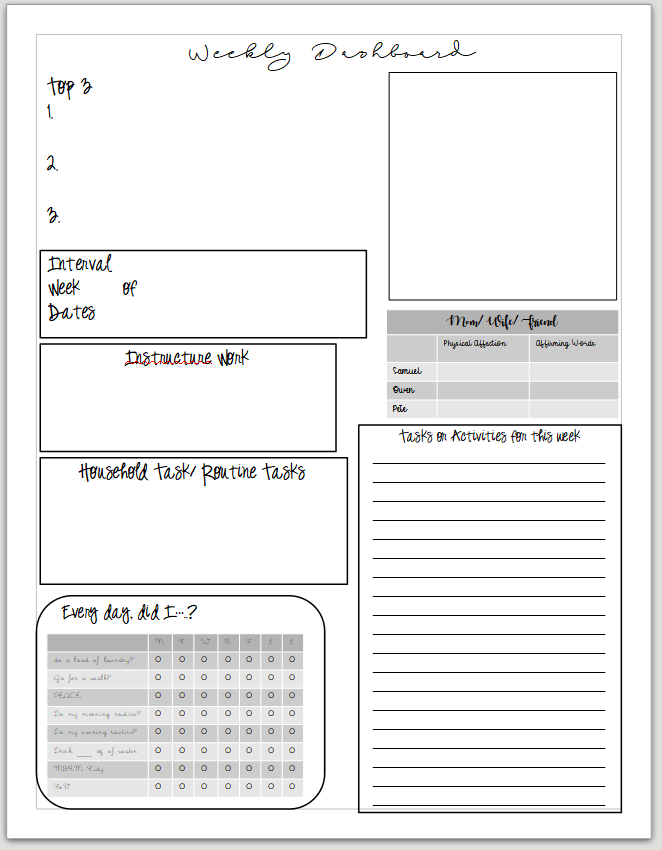
Stefani’s weekly dashboard on a clipboard:
Our Community Manager, Stefani Mons, keeps view of her vocations and daily card post it note on her one-page spread planner:
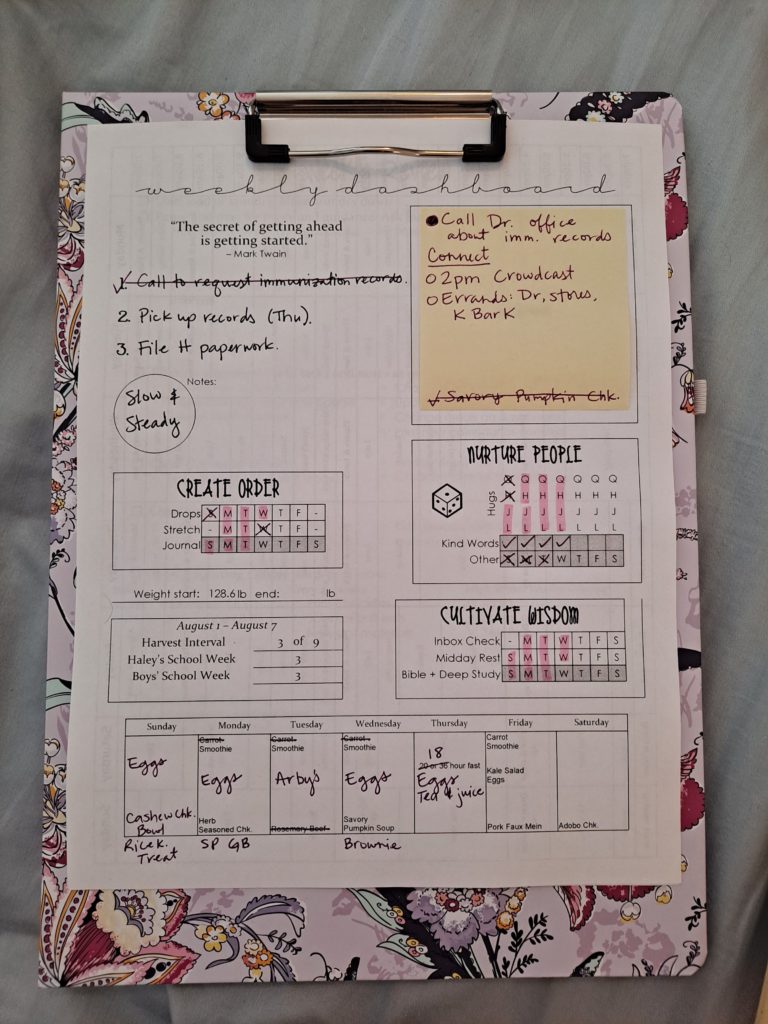
Don’t forget to keep notes with your planner!
It’s tempting to overcomplicate our planners and add rules and routines we never end up keeping.
Our planning system needs a place for notes, and we need to write notes, but that doesn’t need to make it bulky or complex.
Your planner can be quick and simple and flexible.
Aly’s disc-bound homemade weekly dashboard:

“I peeled 5 post its off the pad (in one chunk) and put the whole mini stack on my dashboard so I have it ready and in place for the next day!
--Aly Silva, Convivial Circle Mentor Member
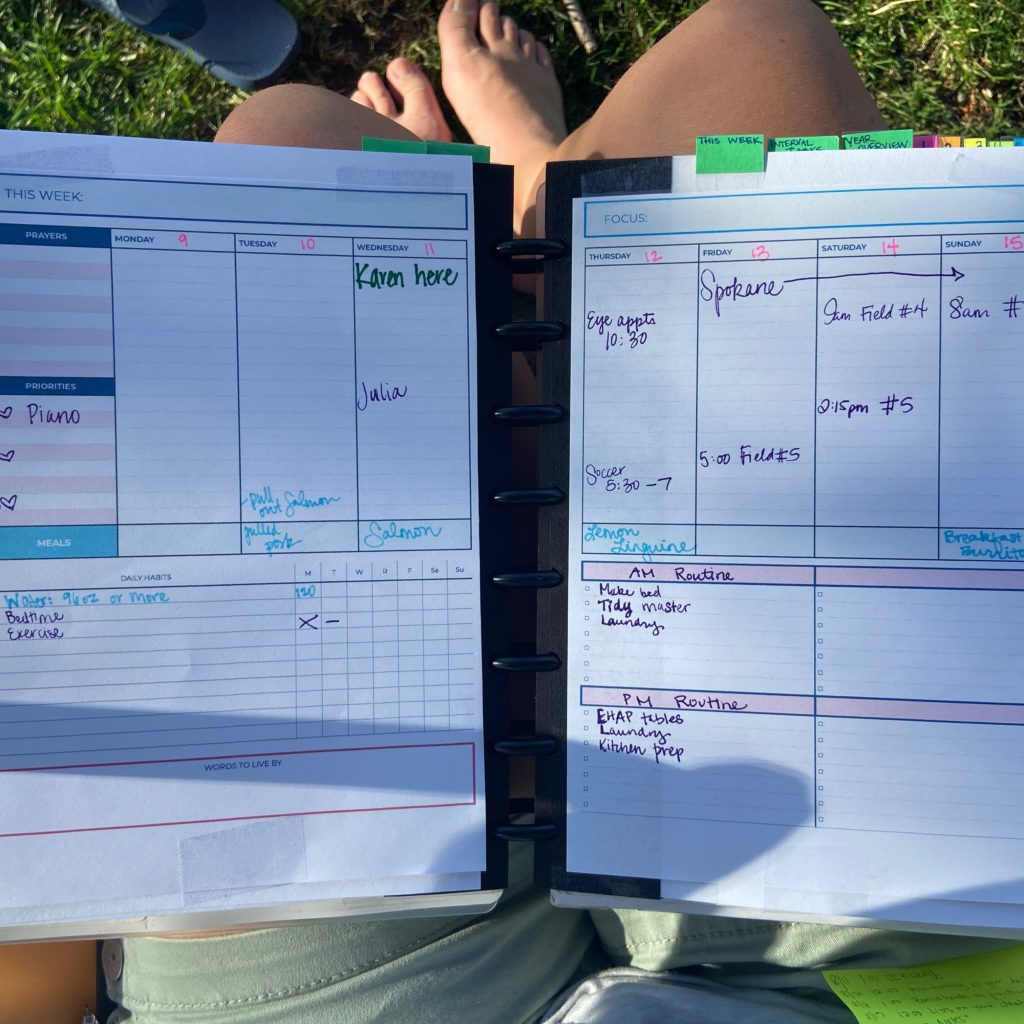

This has been so helpful to think through what actually needs to be on my dashboard. I tend toward too minimalist sometimes because I’m afraid I’ll over clutter it. I just have an alignment quote, my weekly view, top 3, am/pm habits, cleaning loop and this time I write my interval list since it’s the first week of the interval.
--Rena Sites, Convivial Circle Member

I have to write everything out each week to cement it all in my brain, so it works really well for me. And the green is sticky notes for my daily cards. Right now in this season of life I definitely need simple and to the point.
--Chantelle Koontz, Convivial Circle Member
I like to draw my dashboards, because I like to use cardstock for durability and just tactile enjoyment. I often do my menu plan along the bottom of the days, but I didn’t get to it this week. I have been experimenting with decorating them or leaving them basic. The jury is still out on which I prefer. I might move the decorating to my homeschool records page, because my brain doesn’t love having to sort through the decorations to get to the content.
--Cassie Spurlock, Convivial Circle Member
Victoria’s weekly dashboard example:

This is what a “used” version of my week looks like. I’m just under the wire for our monthly topic of dashboards. This demonstrates a technique I sometimes use for project post its or extra lists. I stack them and then title them at the bottom for easy reference.
I’m looking forward to my actual planner arriving this week, as you can tell this is a printout pasted into an existing notebook. Printing out a sample copy is a technique I ALWAYS use before even considering a new planner.
I usually try to use it for at least a month or two unless the planner is extremely cheap or fairly similar to what I a currently using. I highly recommend this for people who are switching planners or are new to purchasing planners.
--Victoria Graf, Convivial Circle Member
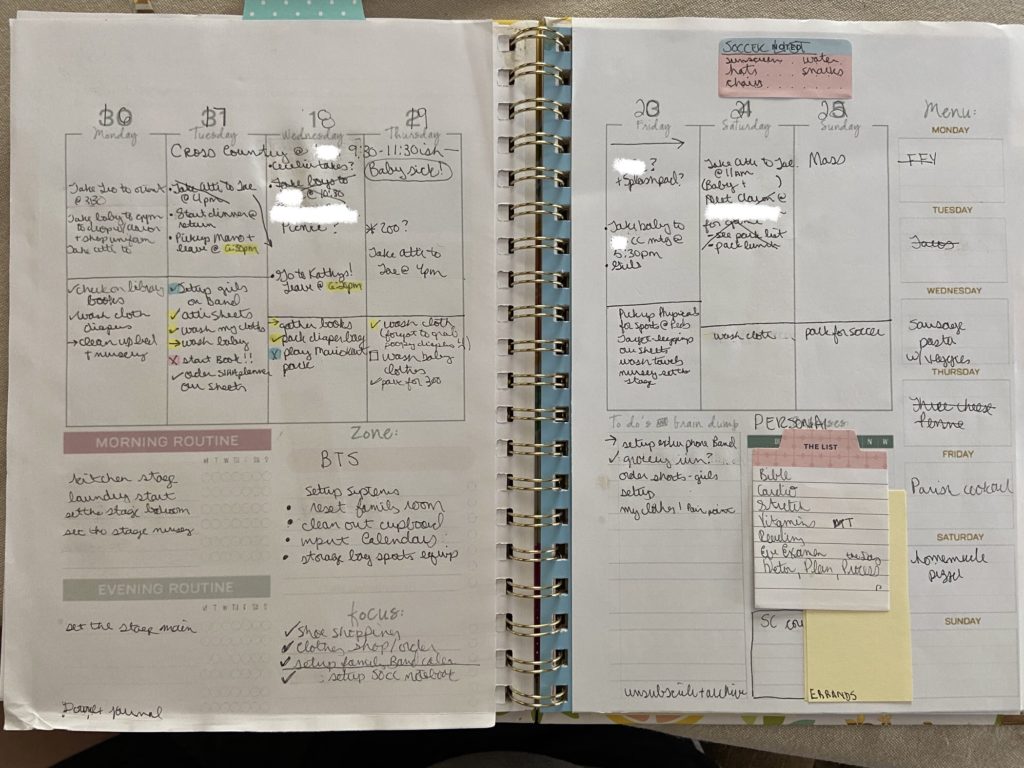
These ladies and more like them are inside Convivial Circle:
We have many more member examples, tips, and ideas. If you need help putting together and using a weekly planning dashboard that fits the busy life of a mom, we are the community for you.
- Get gospel-focused advice and encouragement.
- Level up your plans and progress, one step at a time.
- Find accountability with likeminded women without any social media drama.
- Experience the homemaking mentoring you’ve always wanted.
- Learn to love being a homemaker!
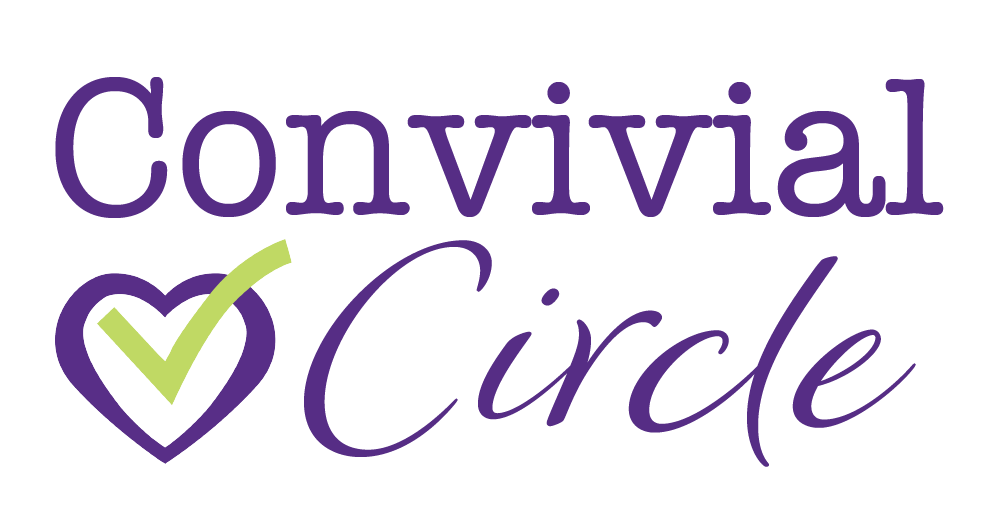
just $27.99/month
(or save with a quarterly or annual plan)

